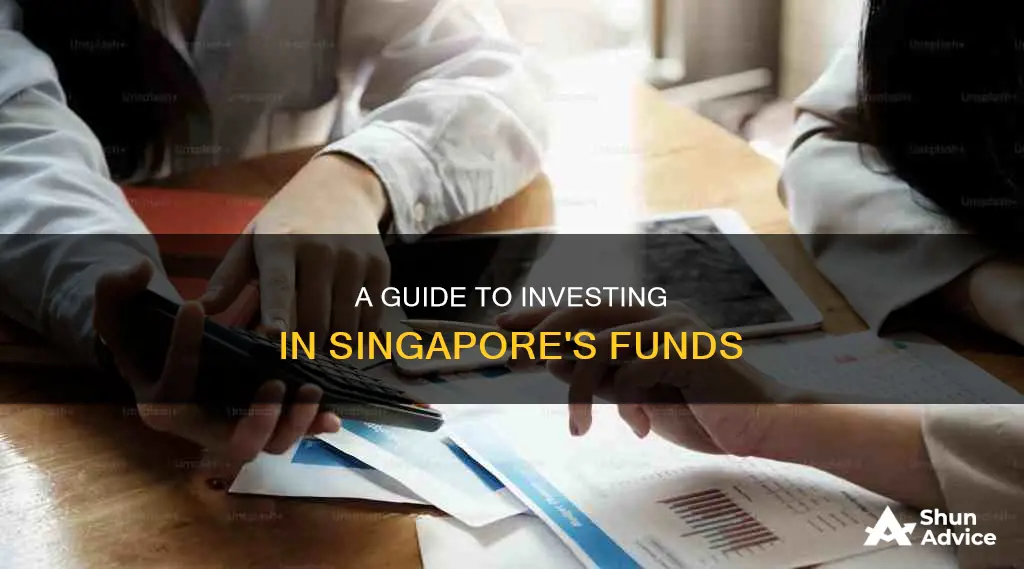
Investing in funds in Singapore can be a daunting task, especially with the myriad of options available. The first step is to understand the different types of investments available, such as stocks, real estate, bonds, cryptocurrencies, and more. Each type of investment comes with varying levels of risk and potential returns. For example, Singapore Savings Bonds (SSBs) are considered low-risk as they are backed by the Singapore Government, while cryptocurrencies are more volatile and high-risk. It is important to assess your financial goals, risk tolerance, and investment horizon before deciding on the types of investments to include in your portfolio. Additionally, investors should be aware of the costs associated with investing, such as management fees and transaction charges, as these can eat into potential returns.
| Characteristics | Values |
|---|---|
| Investment Types | Mutual Funds, Unit Trusts, Exchange-Traded Funds (ETFs), Stocks, Real Estate, Bonds, Cryptocurrencies, Robo Advisors, Retirement Schemes, Insurance Products |
| Investment Methods | Passive Investing, Dividend Investing, Hands-Off Investing, Active Stock Picking, Speculation |
| Investment Accounts | DBS Vickers Young Investor Account, POSB digiPortfolio, Saxo |
| Investment Considerations | Risk Appetite, Investment Period, Desired Returns, Cost of Investment |
| Investment Tools | Financial Calculators, Online Brokerage Platforms, Investment Guides |
What You'll Learn

Passive investing vs active stock picking
Investing in funds is a hot topic in Singapore, especially as it is one of the most expensive cities in the world. But what is the best way to invest? There are two main strategies: passive investing and active stock picking.
Passive investing is a strategy that has gained popularity in recent decades, where investors aim to duplicate market returns instead of trying to beat them. Passive investors rarely buy individual investments but instead hold an investment over a long period or purchase shares of a mutual or exchange-traded fund. This strategy is often chosen for its low fees, good transparency, and tax efficiency. The main benefit of passive investing is that it is a very cost-effective way to invest, as it requires less buying and selling. Passive investors also do not need to analyse securities in the index, which saves time and money.
However, passive investing has its limitations. Passive funds are restricted to a specific index or set of investments, so investors are locked into those holdings regardless of market changes. Passive funds also tend to have smaller returns, as they are designed to track the market.
Active investing, on the other hand, takes a hands-on approach, where investors regularly search for and buy investments that are performing or that they believe will perform. Active investors aim to "beat the market" and outperform certain benchmarks. This strategy allows for more flexibility, as active managers can buy stocks they believe will perform well and can hedge their bets using techniques like short sales or put options. Additionally, active investing allows for better tax management, as advisors can tailor strategies to individual investors.
However, active investing is generally more expensive due to the extensive research and analysis required, as well as the higher transaction costs from frequent buying and selling. Active investing also carries more risk, as fund managers can make costly mistakes.
So, which strategy is better? While passive investing has historically earned more money than active investing, the choice depends on the investor's personal goals and priorities. Many professionals blend the two strategies to take advantage of the strengths of both and further diversify their portfolio.
Retirement Fund Investment: Where to Place Your Money Wisely
You may want to see also

Mutual funds vs unit trusts
In Singapore, investing in unit trusts and mutual funds is a popular way for many to grow their money. Unit trusts and mutual funds are similar in that they are both collective investment structures, pooling money from multiple investors to be managed by a fund manager. However, there are some key differences between the two.
Firstly, in terms of structure, unit trusts are typically British, while mutual funds are more commonly used in America. With unit trusts, investor money is placed in a trust, such as a bank, and the portfolio manager makes transactions based on the fund's mandate and research. In contrast, the money in a mutual fund stays with a fund management company, which allocates it towards various investment opportunities.
Secondly, unit trusts are usually actively managed, meaning the fund manager tries to outperform a benchmark index, whereas mutual funds can be actively or passively managed. Passively managed funds simply mirror an index and do not require the same level of decision-making as actively managed funds, resulting in lower operating and management costs.
Thirdly, unit trusts are bought directly from the fund manager and can only be bought or sold at the end of the trading day, whereas ETFs (a type of mutual fund) are traded on the stock market and can be bought and sold through a broker at any time during the trading day. This makes ETFs more liquid than unit trusts.
Lastly, unit trusts and mutual funds differ in their fees and charges. Both have initial service charges, management fees, and other miscellaneous fees. However, unit trusts also have a deferred sales charge, also known as a back load, which is charged when you trade a trust.
Robinhood Market Fund Investment: A Beginner's Guide
You may want to see also

Exchange-traded funds (ETFs)
ETFs are a good way to get into investing if you're not confident in picking individual stocks. With an ETF, you gain exposure to a diverse range of stocks, bonds, or other asset classes, depending on the ETF you choose. This helps to diversify your portfolio at a low cost. Diversification is a way to reduce your investment risk by spreading your investments across different assets.
ETFs are traded on the open market, making them highly liquid. Investors can buy and sell ETFs at any time, as long as they have a brokerage account and a Central Depository (CDP) account. There is also a low barrier to entry with ETFs; you can invest in top companies at a fraction of the price, without minimum investment amounts. For example, the STI ETF is around $2.51, while a single stock within the STI, like DBS, is about $20.
There are thousands of ETFs available on the market, offering a wide variety of choices. You can choose ETFs from different asset classes, geographies, industries, countries, and stock exchanges. The type of ETF you select will depend on your investment goals, preferences, and current portfolio.
Some examples of popular ETFs include:
- SPDR S&P 500 ETF, which tracks the S&P 500 index of the largest 500 companies listed on US stock exchanges
- Invesco QQQ ETF, which tracks the Nasdaq 100 Index
- SPDR Dow Jones Industrial Average ETF, which tracks the Dow Jones Industrial Average
- ABF Singapore Bond Index Fund and Nikko AM SGD Investment Grade Corporate Bond ETF (bond ETFs)
- SPDR Gold Shares ETF, iShares Silver Trust, and iShares MSCI Global Agriculture Producers ETF (commodity ETFs)
- Real Estate Investment Trusts (REITs), such as NikkoAM-Straits Trading Asia Ex-Japan REIT ETF, Phillip SGX APAC Dividend Leaders REIT ETF, and Lion-Phillip S-REIT ETF
- Country-specific ETFs like iShares MSCI China ETF, which allow you to increase your exposure to overseas markets
Bluechip Fund Investment: Strategies for Success
You may want to see also

Robo advisors
- StashAway: One of the most well-known robo advisors in Singapore, StashAway is user-friendly and transparent about its fees. It offers a range of portfolios, including general investing, goal-based investing, responsible investing, and cash management.
- SaxoWealthCare: This robo advisor helps you build portfolios centred on your life goals. It offers three trading styles: Global Growth, Asian Growth, and Sustainable Growth.
- SqSave: SqSave is one of the oldest robo advisors in Singapore and utilises machine learning AI to create unique portfolios for each investor. It has a minimum investment requirement of just S$1, making it accessible to those with smaller investment amounts.
- UOB UTRADE Robo: As a bank-run robo advisor, UOB UTRADE Robo offers a higher degree of safety than other platforms. It has a competitive fee structure, with fees starting at 0.50% p.a. and capping out at 0.88% p.a.
- Kristal.AI: Kristal.AI offers a high degree of control, allowing users to either create their own portfolios or choose from pre-built portfolios. It has a low fee structure, with no management fees up to US$10,000 and only 0.3% p.a. thereafter.
- Syfe: Syfe offers a wide range of preset portfolios, including REIT+, which provides exposure to Singaporean real estate. It also offers factor-based equity portfolios and cash management accounts with competitive rates.
- OCBC RoboInvest: OCBC RoboInvest offers 38 unique portfolios across six markets, including thematic investment portfolios such as Gen Z Winners, US Cloud Computing, and China Growth. It has a low minimum investment requirement of US$100.
- Endowus: Endowus allows you to invest your CPF Ordinary Account (OA) funds and offers a flat, affordable management fee of 0.3% p.a. It also provides access to actively managed fixed-income products like Dimensional and PIMCO.
- AutoWealth: AutoWealth utilises a fixed-fee structure, charging a management fee of 0.5% p.a. and a platform fee of US$18, regardless of your investment amount. It invests in a range of ETFs and assigns each client a wealth manager.
Mutual Fund Investment: Timing and Location Strategies
You may want to see also

Singapore Savings Bonds (SSBs)
SSBs are a special type of Singapore Government Securities (SGS) with features that make them suitable for individual investors. They are fully backed by the Singapore Government, which has received the strongest "AAA" credit rating from international credit rating agencies. This means that you can always get your investment amount back in full with no capital loss. The interest rates for SSBs are based on the average SGS yields the month before applications for that issue open.
The minimum amount to invest in SSBs is $500, and the maximum individual holding is $200,000. The interest rates "step up" (increase) each year, and you can redeem your SSBs in any given month without penalty. There is no need to decide on a specific investment period at the start. If you decide to redeem your SSB early, you will receive a lower return, with pro-rated or accrued interest.
To invest in SSBs, you must be 18 years or older and have a bank account with one of the three local banks (DBS/POSB, OCBC, or UOB) and an individual CDP Securities account. You can apply through DBS/POSB, OCBC, and UOB ATMs or internet banking, or OCBC's mobile application.
Vanguard Funds: Best Bets for New Investors
You may want to see also
Frequently asked questions
There are a few types of funds available in Singapore, including mutual funds, unit trusts, exchange-traded funds (ETFs), and investment-linked life insurance products.
Mutual funds offer a diversified portfolio of stocks, bonds, and other securities, allowing investors to own a wide range of assets without actively monitoring their portfolio. Fund managers handle the investments on behalf of the investors.
You can start investing in funds in Singapore with a small amount of money. Some investment options, like Regular Savings Plans (RSPs), portfolios of global equities, REITs, bonds, and cryptocurrencies, require less than $1,000 to get started.







